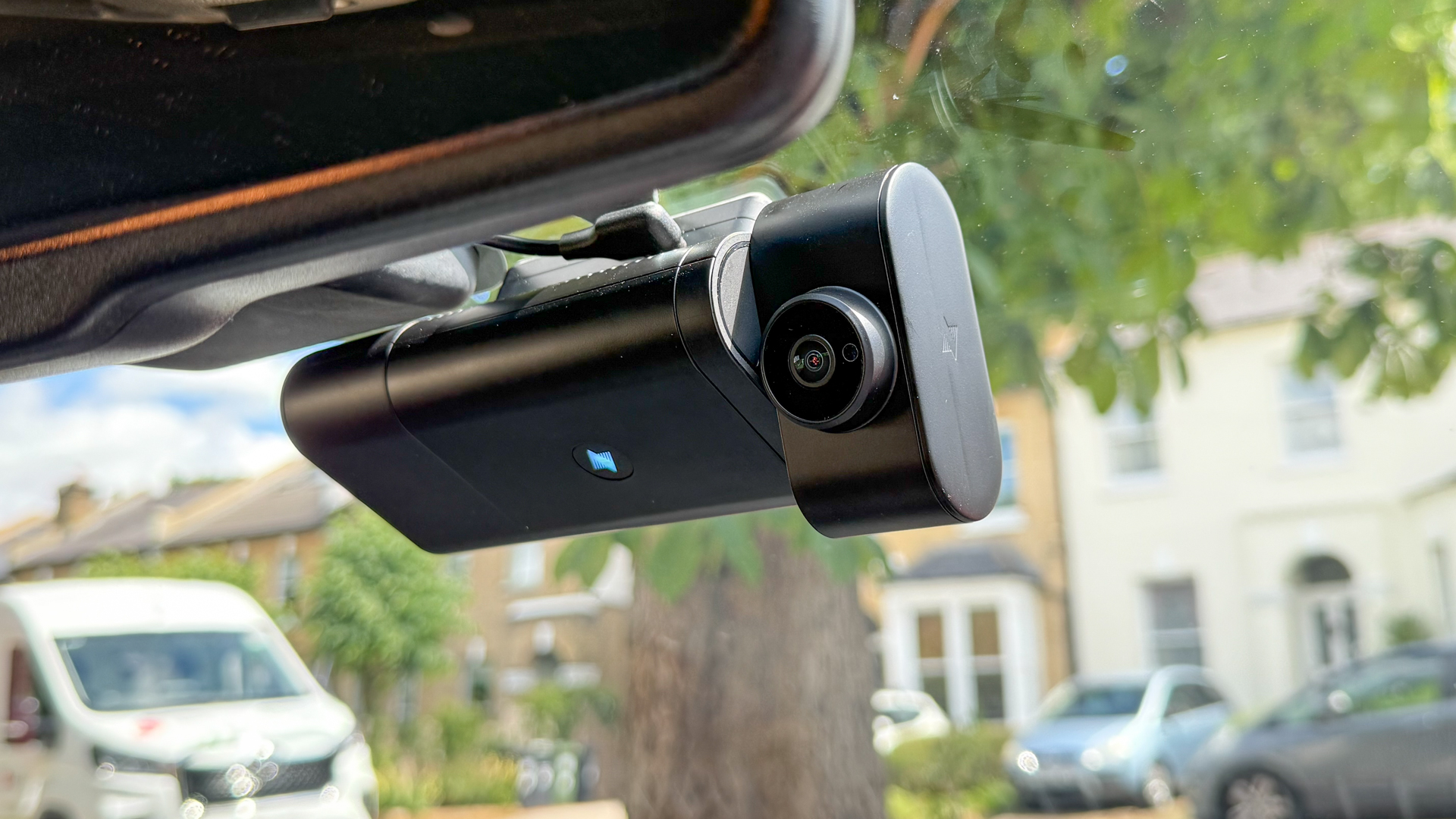Why you can trust TechRadar
We spend hours testing every product or service we review, so you can be sure you’re buying the best. Find out more about how we test.
Nexar One: One-minute review
The Nexar One is a 4K dash cam that employs a clever modular design and an always-on LTE data connection to offer automatic cloud uploads with unlimited storage, wireless video transfer, and remote streaming. It can be bought with either 128GB or 256GB of internal storage, but there’s no microSD card support. Rear and internal cameras are also available.
Unlimited cloud storage and live streaming for as little as $71.90 a year feels like good value, but the One is reliant on a strong cellular signal to work properly; if you have patchy 4G at home, this might not be the dash cam for you.
Nexar One: price & availability
The Nexar One is priced from $329.95 for the 128GB model (which can hold up to 37 hours of recordings), or from $379.95 for the 256GB model (which has space for up to 78 hours). Adding the interior camera featured in this review increases those prices to $379.95 and $429.95 respectively.
Nexar’s LTE Protection Plan costs $9.99 a month or $71.90 a year. This includes the ability to live stream from the dash cam to your phone, plus unlimited cloud storage, a 24/7 parking mode, real-time GPS tracking, emergency alerts, and rear camera compatibility.
Nexar says the One will be available in the UK soon, but hadn’t announced prices at the time of review in June 2025. The cost of the LTE Protection Plan is also unknown for now, and the One is not available in Australia.
Nexar One: specs
|
Video |
4K resolution at 25 to 30 frames per second |
Row 0 – Cell 2 | Row 0 – Cell 3 |
|
Field of view (FoV) |
140 degrees (forwards), 160 degrees (interior) |
Row 1 – Cell 2 | Row 1 – Cell 3 |
|
Storage |
Internal (128GB or 256GB), cloud (unlimited, fees apply) |
Row 2 – Cell 2 | Row 2 – Cell 3 |
|
GPS |
Yes |
Row 3 – Cell 2 | Row 3 – Cell 3 |
|
Parking Mode |
Yes, with remote streaming |
Row 4 – Cell 2 | Row 4 – Cell 3 |
|
App support |
Nexar Connect app |
Row 5 – Cell 2 | Row 5 – Cell 3 |
|
Dimensions |
3.5 x 2.75 x 1.2 inches / 88.9 x 69.8 x 30.5mm |
Row 6 – Cell 2 | Row 6 – Cell 3 |
|
Weight |
7.4oz / 210g |
Row 7 – Cell 2 | Row 7 – Cell 3 |
|
Battery |
Yes, used to record parking events |
Row 8 – Cell 2 | Row 8 – Cell 3 |
Nexar One: Design
The Nexar One is a clever piece of design, as far as dash cams go. It doesn’t have a screen, so there’s no chance of being distracted while you’re driving, and the unit itself is relatively slim, but with the LTE data module and interior camera connected, it’s quite large.
The clever bit is how the Nexar One uses magnets. Firstly, it connects to its windshield mount with a very strong magnet. You then stick the mount to your windshield with an adhesive strip, and a power cable runs from the mount to your car’s OBD2 port for a constant power supply, even when it’s parked and turned off. Power is then sent to the dash cam itself as soon as the magnets snap it into place.
There are more magnets on either side of the main unit. You can remove a cover from one end to attach what Nexar calls the connectivity add-on, which is basically an LTE (4G) antenna that gives the dash cam a cellular data connection for live streaming to your phone and cloud video storage – more on that later.
Removing the cover from the other end enables you connect the optional interior camera, which sold separately but was also provided by Nexar for this review. Overall, it’s a clever design that’s been nicely executed, and I especially like how Nexar includes an OBD2 cable in the box, rather than a USB cable and a 12-volt socket adapter.
As mentioned, there’s no microSD card slot, with the One relying entirely on internal storage.
Nexar One: Performance
The setup process requires the Nexar Connect smartphone app and, for the dash cam, a decent 4G connection. Although I live in London, my street has awful cellular coverage, so it wasn’t a surprise to see the One fail to get itself online. I drove about half a mile, parked up, and the dash cam then quickly connected to Nexar’s cloud service and completed the setup process.
While video quality is the most important aspect of any dash cam, there’s more to this model than video recording. You can use either the Nexar Connect app or Nexar’s online dashboard to view every journey completed with the One installed. Your driving route is shown on a map, along with the distance and duration of your journey. It’s then easy to either view a low-resolution timelapse of a journey, or download a high-resolution portion.
If you’re away from your car (and therefore not connected directly to the dash cam via Wi-Fi), you can view the mapped routes and timelapses. And, while you can request to download a high-res portion of between 30 seconds and five minutes, the download won’t happen until the next time you turn your car on. Instead, it’s best to get in your car, connect directly to the dash cam over Wi-Fi, and transfer high-res recordings to your phone.
Another feature is live streaming, where the Nexar One’s LTE connection lets you view a live feed from the dash cam on your phone. This takes about 30 seconds to start and when using LTE (instead of a direct Wi-Fi connection) you’re limited to three minutes of live viewing at a time. This is understandable, given how much data would be swallowed up by longer streams. It’s a handy way to check up on your car, and means you can view a live feed right after the dash cam detects a collision while parked, as it will automatically start recording.
Since I live in an area with patchy cellular coverage, some driving routes and timelapses failed to upload right away. This process happens after you park up, while the dash cam is powering down, but a poor data connection can stop the upload from happening. The downloads are then unavailable until the next time you turn your car on and drive to an area with better signal.
If you live and mostly drive in an area with strong LTE coverage you’ll be fine, but if not – and you want to regularly use the Nexar One’s connected features – you’ll need to think twice about buying it. The Nexar One is designed to connect to a range of networks, instead of just one, so it should always hunt out the best signal. But I found it sometimes failed to connect, especially in known blackspots.
Incidents – where the dash cam detects a collision, either while parked or driving – are sorted into their own section of the app and dashboard, making them easy to find.
The app lets you pick from three video quality options, but frustratingly these use names – Basic, Standard and Premium – instead of recognizable numbers, like 1080p or 4K. Tapping on ‘Learn more’ opens Nexar’s website and explains that Basic is 720p (and 540p for the interior view), Standard is 1080p (and 720p for the interior), and Premium is 4K (plus 720p again for the interior).
Standard is the default option. These Full HD recordings look great on the phone app, but quality takes a dip when blown up onto a larger computer screen. Footage is okay, but details like the license plates of oncoming vehicles, even at just 20mph in bright daylight, are often difficult to read.
Bump the Nexar One up to Premium and the 4K videos are noticeably sharper, with more legible license plates and street signs. Files are also larger, with a five-minute clip weighing in at 1.5GB from the front-facing camera and 360MB from the lower-spec interior view.
The larger size of 4K files highlights the Nexar One’s slow Wi-Fi transfer speeds. Moving those five-minute, 1.5GB and 360MB clips to my iPhone, over a direct Wi-Fi connection, took a full five minutes.
The interior camera is of a lower spec, but still provides a decent view of the driver and front-seat passenger. Since I drive a small two-seater (a Mazda Miata, or MX-5 for non-US readers), this camera manages to capture an acceptable view out of the rear windshield too. However, due to my car’s tiny front windshield, I’ve had to partially hide the Nexar One behind the mirror, which blocks some of the camera’s interior view.
If I bought the Nexar One myself, and still owned a car tight on space, I’d likely do without the interior camera. That said, if you’re a taxi or ride-share driver, having recordings of your interior (and a sign telling your passengers as much) could be useful.
Lastly, there’s a parking mode. This works when the Nexar One is connected either with the included OBD II cable, or the optional hardwiring cable that powers it from the fuse box. When a collision is detected, the camera springs into life and starts recording. These videos appear in chronological order in the app, but can only be downloaded when you next switch your car on – and so long as the camera has a good cellular connection.
Parking mode, unlimited cloud storage, live streaming and other functions – including emergency alerts, GPS tracking and rear camera compatibility – are all part of a subscription plan. This is priced at $9.99 a month or $71.90 for a full year. Although the Nexar One works like any other offline dash cam without this fee, storing footage locally, not subscribing removes much of its functionality. If you don’t want to pay for a subscription, you’d be better off buying a different dash cam.
That said, I can see the value here – especially if you live in an area with solid cellular coverage. Having videos available online, through the app or any computer browser, takes away the usual dash cam pain point of having to eject the microSD card and transfer footage manually. I also like the idea of being able to check in on my car while I’m away from home, but my local cellular coverage made that tricky.
The dash cam occasionally sent phone notifications, promising more information when tapped. But doing so simply opened the app and showed me the home screen. It also sometimes told me a recording was in process (while the car was parked and switched off), then saved a five-minute journey in the Activity page of the app. Tapping on this brought up a page full of error messages, a map with no indication of where the car was, and the promise of a timelapse and high-res clip being “available shortly”.
Nexar told me it has had some issues with a recent firmware update, but after reinstalling the latest firmware I still experienced connectivity problems. The One connects to multiple phone networks, but it seems that none could provide the coverage it needed to function where I live. It worked fine elsewhere, but poor signal at home takes away a chunk of the One’s functionality.
I asked Nexar if it can be connect to home Wi-Fi for video uploads and firmware updates but, and was told that while this is on the roadmap, there’s no timeline for launch.
Nexar One: Sample videos
Front camera
Interior camera
Should you buy the Nexar One?
Buy it if…
Don’t buy it if…
How I tested the Nexar One
- I installed the Nexar One in my own car
- I used the dash cam during multiple journeys over the course of a week
- I downloaded footage, adjusted settings and experimented with the live streaming function.
I installed the Nexar One in my car and used it as my dash cam for about a week. I used it on numerous journeys, and recorded footage every time I used my car. I then downloaded (and uploaded) footage from the dash cam to check its recording quality, and used the live streaming function to see how well that worked.
Read the full article here














